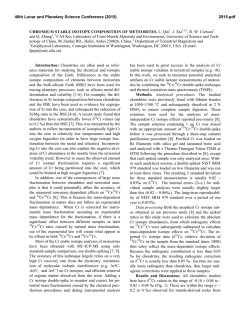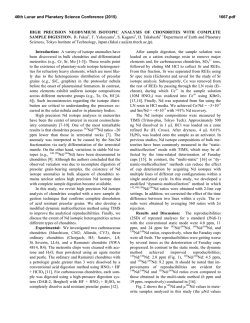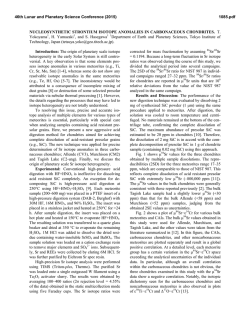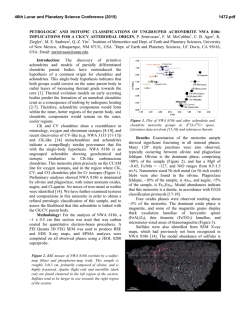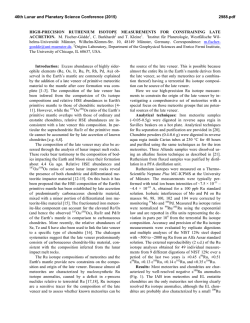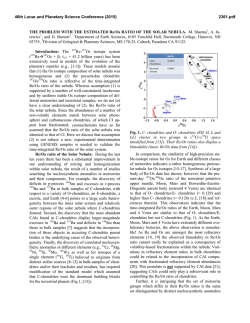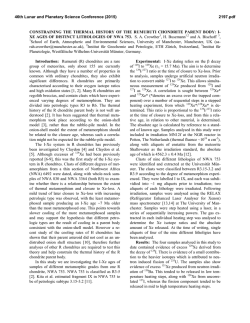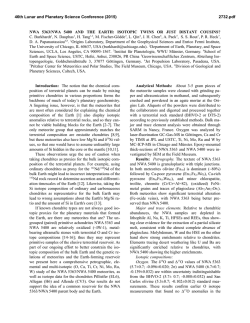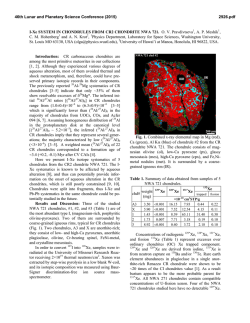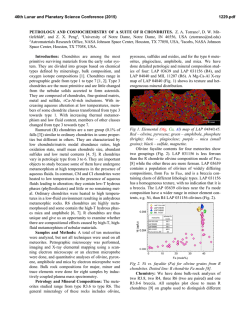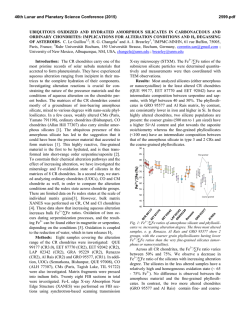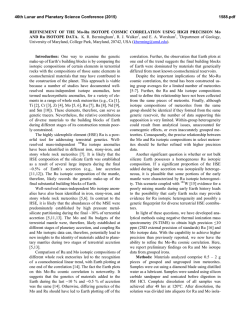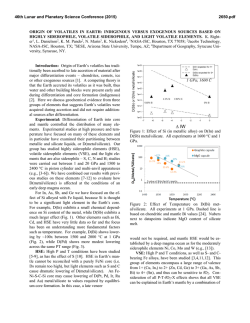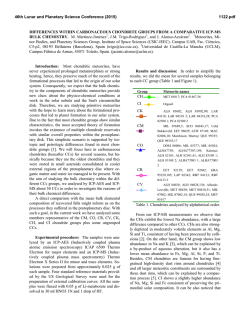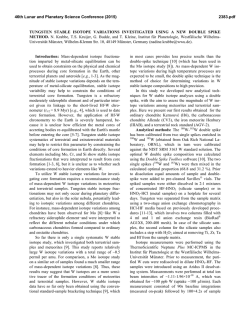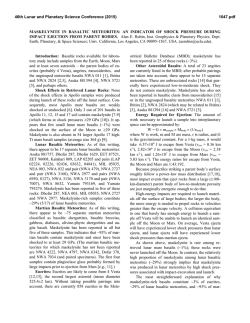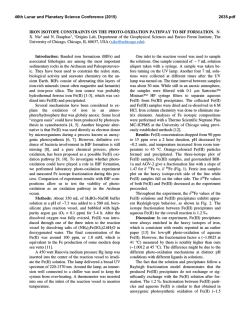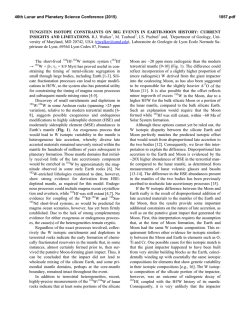
NEBULAR FRACTIONATION (NOT CORE FORMATION) IS
46th Lunar and Planetary Science Conference (2015) 1417.pdf NEBULAR FRACTIONATION (NOT CORE FORMATION) IS RESPONSIBLE FOR THE HEAVY SILICON ISOTOPE COMPOSITIONS OF ANGRITES AND EARTH. N. Dauphas1, F. Poitrasson, and C. Burkhardt2, 1Origins Laboratory, Department of the Geophysical Sciences and Enrico Fermi Institute, The University of Chicago ([email protected]), 2Laboratoire Géosciences Environnement Toulouse, CNRS UMR 5563UPS-IRD, France. Introduction: The bulk silicate Earth (BSE), as sampled by mantle peridotites and mantle-derived magmas, has a heavy silicon isotope composition relative to chondrites [1-4]. The difference of ~0.15 ‰ or more in δ30Si between the BSE and chondrites has been ascribed to equilibrium isotopic fractionation during partitioning of silicon into Earth’s core [1-6], which would also explain why the BSE has a higher Mg/Si than chondrites. Based on ab initio calculations and experimental calibrations of equilibrium Si isotopic fractionation between metal and silicate [3,5,6], the difference in δ30Si between the BSE and chondrites was used to estimate how much Si is in Earth’s core [1-6]. Silicon is one of the likely candidates to explain the density deficit of Earth’s core relative to pure FeNi alloy, so estimating its abundance in the core has important implications for geochemistry and geophysics [7]. However, not all chondrite groups have the same Si isotopic composition and this poses a major difficulty for interpreting the terrestrial δ30Si record with respect to Si partitioning in the core. EH chondrites have low δ30Si values of -0.7 ‰ while carbonaceous chondrites have δ30Si values of -0.4 ‰. Depending on what is assumed for Earth’s building blocks, the estimated amounts of Si in Earth’s core range from ~10 wt% for carbonaceous or ordinay chondrites to ~40 wt% for enstatite chondrites [4,8]. The latter estimate is unrealistic because the maximum amount of Si in the core that is needed to explain its density deficit is ~11 wt% [7]. The former estimate is more in line with the equation of state of Fe-Si alloy but ordinary and carbonaceous chondrites display isotopic anomalies relative to Earth (e.g., in 17O, 48Ca, 54Cr, 50Ti, 62Ni, 92 Mo) [9,10]. We are thus left with the difficulty that to estimate how much Si is in Earth’s core, one needs to know what the Earth is made of, and it seems that none of the meteorite groups documented so far can be taken as representative of the building blocks of the Earth. To address this shortcoming, we have decided to document Si isotopic variations in meteorite groups that had not been studied previously. We have found that angrites have δ30Si identical to the silicate Earth (also see [11,12]). We show that the variations in δ30Si values of chondrites, differentiated meteorites, and the bulk silicate Earth are best explained by fractionation of forsterite during condensation in the nebula. We conclude that δ30Si values are not suitable proxies of Si partitioning in planetary cores but instead are best used to estimate the Mg/Si ratios of bulk planetary bodies. Samples, methods and results: The silicon isotope measurements were made at GET (Toulouse) using well-established procedures [4]. The samples selected for study are the paired ungrouped achondrites NWA 5363 and NWA 5400, the angrites D’Orbigny, NWA 1670, Sahara 99555, NWA 6291, the chondrites Allegan (H5) and Pillistfer (EL6), as well as a basalt geostandard from Hawaii (BHVO-2). The chondrites and the geostandard were selected to evaluate the accuracy of the measurements and their δ30Si values agree well with those reported in previous studies. NWA 5363 and NWA 5400 are brachinite-like achondrites with a Δ17O indistinguishable from the terrestrial value [13]. Other elements, such as Ti, display isotopic anomalies in NWA 5363/5400, which therefore cannot be a direct remnant of the building blocks of the Earth [13]. Angrites were selected because they sample a relatively oxidized achondrite parent-body and their δ56Fe values are high relative to chondrites, as has also been observed in terrestrial basalts [14]. No differences were found in δ30Si values between meteorite falls vs. finds or samples that have experienced different degrees of weathering, indicating that Si isotopes in meteorites are largely immune to terrestrial weathering. The paired meteorites NWA 5363 and NWA 5400 have identical Si isotopic compositions, close to those of ordinary and carbonaceous chondrites (Fig. 1). Angrites have δ30Si values that are similar or even slightly higher than the terrestrial value. These results agree with independent measurements of angrites by [12]. Angrites are the first meteorite group other than lunar samples that display BSE-like Si isotopic compositions (Fig. 1). Discussion: The heavy Si isotope composition of the silicate Earth was taken as evidence that significant amounts of Si had partitioned in the core [1-8]. We have found that angrites have a Si isotope composition indistinguishable from the silicate Earth. Angrites cooled rapidly, within ~5 Myr of condensation of refractory inclusions for quenched angrites [15 and references therein]. This indicates that they most likely come from a small planetary body as otherwise, protracted cooling and associated magmatism and tectonism would not have allowed those rocks to remain unaffected. Furthermore, they come from a parent- 46th Lunar and Planetary Science Conference (2015) body that was relatively oxidized. The fO2 recorded by angrites is around IW+1, which is high compared to many planetary basalts. The inferred fO2 during core formation of the angrite parent-body is also quite elevated (IW-1) [16]. The only two ways by which Si can quantitatively partition into a planetary core are high pressure (e.g., 40 GPa relevant to core formation on Earth) or low oxygen fugacity (e.g., IW-5). None of these conditions apply to angrites and one can exclude the possibility that Si partitioned into the core of the angrite parent-body. Pringle et al. [12] argued that impacts caused Si evaporation and fractionation in angrites. However, impacts between planetesimals are not efficient to induce large-scale melting, let alone vaporization [17]. Furthermore, impacts are constitutive of the accretion history of planetesimals and it is not clear why only angrites should display such a heavy Si isotope signature while other large asteroids (Vesta, as sampled by HEDs) do not. As discussed by Dauphas et al. [9,11], the most likely cause for the observed spread in δ30Si among planetary bodies is fractionation by evaporation/condensation processes in the solar nebula. Forsterite has a high Mg/Si ratio and represents a large fraction of condensable matter during cooling of solar gas. Removal or addition of a forsteritic component from or to solar gas is thus the most likely reason why Mg/Si ratios vary from one chondrite group to another [18]. At equilibrium, forsterite is fractionated relative to SiOg by ~2 ‰ at 1350 K [19], the temperature relevant to forsterite condensation in the nebula [20]. One would thus expect the planetary objects with high Mg/Si ratios (that have incorporated more of the forsterite component) to display higher δ30Si values and vice versa. This is exactly what is observed (there is a broad correlation in chondrites between Mg/Si ratios and δ30Si values) [2,9]. The bulk silicate Earth also plots on this correlation. The finding that angrites have high δ30Si values fills the isotopic gap between chondrites and the silicate Earth and demonstrates that nebular fractionation can explain the high δ30Si value of the silicate Earth, with no need to invoke Si partitioning in the core; or only at a level (~4 wt%) significantly lower than what had been inferred before. Conclusions: Angrites have a Si isotope composition similar to the silicate Earth. The only viable explanation for this signature is nebular equilibrium Si isotope fractionation between forsterite condensate and gaseous SiO. The heavy Si isotope composition of the silicate Earth may also reflect the same process, with no need to invoke partitioning of large amounts of Si in the core (~4 wt% Si). The heavy Si isotope composition of the Earth was largely inherited from its build- 1417.pdf ing blocks and the Moon-forming impactor was probably sourced from the same reservoir [11]. This can naturally explain the indistinguishable Si isotope compositions of the Moon and the silicate Earth, which cannot be easily explained by Si partitioning in Earth’s core. Silicon isotopes are best used as proxies of the Mg/Si ratio of bulk planetary bodies. NWA5363 PB Angrite PB Moon BSE HED PB (Vesta) Mars Urelite PB CC OC EL EH Figure 1. Silicon isotope compositions of angrites and NWA 5363/5400 (this study) compared with values for chondrites (EH and EL=enstatite; OC=ordinary; CC=carbonaceous), ureilites, Mars (SNC), Vesta (HED), the bulk silicate Earth (BSE) and the Moon. The high δ30Si values of angrites relative to chondrites most likely reflects equilibrium Si isotopic fractionation between condensate forsterite and gaseous SiO. References: [1] Armytage R.M.G. et al. (2011) GCA, 75, 3662-3676. [2] Fitoussi C. et al. (2009) EPSL, 287, 7785. [3] Georg et al. (2007) Nature 447, 1102-1106. [4] Zambardi T. et al. (2013) GCA 121, 67-83. [5] Hin R. et al. (2014) EPSL 387, 55-66. [6] Shahar A. et al. (2011) GCA 75, 7688-7697. [7] Hirose K. (2013) AREPS 41, 657-691. [8] Fitoussi C., Bourdon B. (2012) Science 335, 1477-1480. [9] Dauphas N. et al. (2014) EPSL 407, 96-108. [10] Warren P.H. (2011) EPSL 311, 93-100. [11] Dauphas N., Poitrasson F., Burkhardt C. (2014) Fall AGU conference, V24A-01. [12] Pringle E.A. et al. (2014) PNAS 111, 17029-17032. [13] Burkhardt C. et al. (2015) LPSC 46 (this conference). [14] Wang K. et al. (2012) GCA 89, 31-45. [15] Tang and Dauphas (2012) EPSL 359-360, 248-263. [16] Righter K. (2008) LPSC XXXIX, #1936. [17] Ciesla F.J. et al. (2013) MAPS 48, 2559-2576. [18] Larimer J.W., Anders E. (1970) GCA 34, 367-387. [19] Clayton R.N. et al. (1978) Proc. LPSC 9, 1267-1278. [20] Yoneda S., Grossman L. (1995) GCA 59, 3413-3444. [11] Dauphas N., Burkhardt C., Warren P.H., Teng F.-Z. (2014) Phil. Trans. R. Soc. A 372, 20130244.
© Copyright 2025
